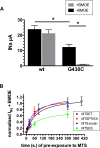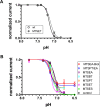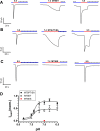Proton and non-proton activation of ASIC channels
- PMID: 28384246
- PMCID: PMC5383329
- DOI: 10.1371/journal.pone.0175293
Proton and non-proton activation of ASIC channels
Abstract
The Acid-Sensing Ion Channels (ASIC) exhibit a fast desensitizing current when activated by pH values below 7.0. By contrast, non-proton ligands are able to trigger sustained ASIC currents at physiological pHs. To analyze the functional basis of the ASIC desensitizing and sustained currents, we have used ASIC1a and ASIC2a mutants with a cysteine in the pore vestibule for covalent binding of different sulfhydryl reagents. We found that ASIC1a and ASIC2a exhibit two distinct currents, a proton-induced desensitizing current and a sustained current triggered by sulfhydryl reagents. These currents differ in their pH dependency, their sensitivity to the sulfhydryl reagents, their ionic selectivity and their relative magnitude. We propose a model for ASIC1 and ASIC2 activity where the channels can function in two distinct modes, a desensitizing mode and a sustained mode depending on the activating ligands. The pore vestibule of the channel represents a functional site for binding non-proton ligands to activate ASIC1 and ASIC2 at neutral pH and to prevent channel desensitization.
Conflict of interest statement
Figures












Similar articles
-
Acid-sensing ion channel 2 (ASIC2) modulates ASIC1 H+-activated currents in hippocampal neurons.J Biol Chem. 2004 Apr 30;279(18):18296-305. doi: 10.1074/jbc.M312145200. Epub 2004 Feb 11. J Biol Chem. 2004. PMID: 14960591
-
ASIC-like, proton-activated currents in rat hippocampal neurons.J Physiol. 2002 Mar 1;539(Pt 2):485-94. doi: 10.1113/jphysiol.2001.014837. J Physiol. 2002. PMID: 11882680 Free PMC article.
-
Cell-Type-Specific Expression Pattern of Proton-Sensing Receptors and Channels in Pituitary Gland.Biophys J. 2020 Dec 1;119(11):2335-2348. doi: 10.1016/j.bpj.2020.10.013. Epub 2020 Oct 22. Biophys J. 2020. PMID: 33098866 Free PMC article.
-
Biophysical properties of acid-sensing ion channels (ASICs).Neuropharmacology. 2015 Jul;94:9-18. doi: 10.1016/j.neuropharm.2014.12.016. Epub 2015 Jan 10. Neuropharmacology. 2015. PMID: 25585135 Review.
-
Genetic exploration of the role of acid-sensing ion channels.Neuropharmacology. 2015 Jul;94:99-118. doi: 10.1016/j.neuropharm.2014.12.011. Epub 2015 Jan 9. Neuropharmacology. 2015. PMID: 25582292 Review.
Cited by
-
Extracellular Protons Mediate Presynaptic Homeostatic Potentiation at the Mouse Neuromuscular Junction.Neuroscience. 2021 Jul 15;467:188-200. doi: 10.1016/j.neuroscience.2021.01.036. Epub 2021 May 21. Neuroscience. 2021. PMID: 34215419 Free PMC article.
-
Acid-sensing ion channel 1 contributes to pulmonary arterial smooth muscle cell depolarization following hypoxic pulmonary hypertension.J Physiol. 2021 Nov;599(21):4749-4762. doi: 10.1113/JP282231. Epub 2021 Sep 25. J Physiol. 2021. PMID: 34487355 Free PMC article.
-
Alterations in the Ca2+ toolkit in oesophageal adenocarcinoma.Explor Target Antitumor Ther. 2021;2(6):543-575. doi: 10.37349/etat.2021.00063. Epub 2021 Dec 31. Explor Target Antitumor Ther. 2021. PMID: 36046118 Free PMC article.
-
PI3-kinase/Akt pathway-regulated membrane transportation of acid-sensing ion channel 1a/Calcium ion influx/endoplasmic reticulum stress activation on PDGF-induced HSC Activation.J Cell Mol Med. 2019 Jun;23(6):3940-3950. doi: 10.1111/jcmm.14275. Epub 2019 Apr 2. J Cell Mol Med. 2019. PMID: 30938088 Free PMC article.
-
TASK inhibition by mild acidosis increases Ca2+ oscillations to mediate pH sensing in rat carotid body chemoreceptor cells.Am J Physiol Lung Cell Mol Physiol. 2023 Mar 1;324(3):L259-L270. doi: 10.1152/ajplung.00099.2022. Epub 2023 Jan 24. Am J Physiol Lung Cell Mol Physiol. 2023. PMID: 36692168 Free PMC article.
References
-
- Kellenberger S, Schild L. International Union of Basic and Clinical Pharmacology. XCI. structure, function, and pharmacology of acid-sensing ion channels and the epithelial Na+ channel. Pharmacol Rev. 2015;67(1):1–35. doi: 10.1124/pr.114.009225 - DOI - PubMed
-
- Wemmie JA, Taugher RJ, Kreple CJ. Acid-sensing ion channels in pain and disease. Nat Rev Neurosci. 2013;14(7):461–71. PubMed Central PMCID: PMCPMC4307015. doi: 10.1038/nrn3529 - DOI - PMC - PubMed
-
- Escoubas P, De Weille JR, Lecoq A, Diochot S, Waldmann R, Champigny G, et al. Isolation of a tarantula toxin specific for a class of proton-gated Na+ channels. J Biol Chem. 2000;275(33):25116–21. Epub 2000/06/01. doi: 10.1074/jbc.M003643200 - DOI - PubMed
-
- Diochot S, Baron A, Rash LD, Deval E, Escoubas P, Scarzello S, et al. A new sea anemone peptide, APETx2, inhibits ASIC3, a major acid-sensitive channel in sensory neurons. Embo J. 2004;23(7):1516–25. doi: 10.1038/sj.emboj.7600177 - DOI - PMC - PubMed
-
- Diochot S, Baron A, Salinas M, Douguet D, Scarzello S, Dabert-Gay AS, et al. Black mamba venom peptides target acid-sensing ion channels to abolish pain. Nature. 2012;490(7421):552–5. Epub 2012/10/05. doi: 10.1038/nature11494 - DOI - PubMed
MeSH terms
Substances
LinkOut - more resources
Full Text Sources
Other Literature Sources

